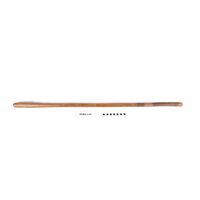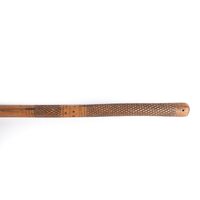Fencing stick
Metadata
Fencing stick
[ Source of title : FHYA using spreadsheet created by Nessa Leibhammer for SAHRIS from JAG materials. ]
Object
JAG 2012-6-25
Creative Commons License: CC BY-NC-ND
https://creativecommons.org/licenses/by-nc-nd/4.0/
Description
[Source - Debra Pryor for FHYA, 2022, using spreadsheet created by Nessa Leibhammer for the South African Heritage Resources Information System (SAHRIS), from JAG materials in 2015: Object description: Stick that flares slightly at the top and at the base. It has engraved crisscross designs at its base covering approximately 1/3 of the shaft.
Object code: JAG 2012-6-25;
Object form type: fencing stick;
Object local name: ;
Object material type: wood;
Technique: carving;
Colours: Brown;
Dimension comment: length: 102;
Object age: 19th century;
Production place: Eastern Cape;
Cultural association: Southern Nguni;
Place of use: Eastern Cape;
Provenance: (i) Prof. Hendrick van der Wateren; (ii) DE-accessioned on closure of Anthropology Museum, University of Potchefstroom.]
Attributions and conjectures
[Source - Nessa Leibhammer for FHYA, 2017: Comments on classification: In his 'A Preliminary Survey of the Bantu Tribes of South Africa', Union of South Africa, Department of Native Affairs, Ethnological Publications, Vol. 5, Pretoria, Government Printer, (1935): 7, 70-83, national government ethnologist, Nicholas Van Warmelo did not use the term "North Nguni". He grouped people living both north and south of the Thukela, under one umbrella term, "Natal Nguni", based on linguistic affinity. His classification was adapted by the ethnology curator, Margaret Shaw, in her 1958 "System of Cataloguing Ethnographic Material in Museums" which determined that items from the region were to be classified as "Natal Nguni: Zulu and others (not differentiated)."
According to art historian, Anitra Nettleton, the classificatory system used by art galleries and museum shifted from Shaw's model to the one where "Natal Nguni" fell away and was replaced by "North/Northern Nguni" for KwaZulu-Natal and Swaziland because scholars found it difficult to distinguish items from adjacent areas, or emigrant people from those from the KZN region. Scholars working with the JAG materials used broad ethno-linguistic categories (Zulu, Xhosa, Tsonga, Shona, Sotho, Tswana) to identify the makers/users of the objects, all of which came to JAG without much by way of provenance, and identification was based on factors such as object type, materials, formal composition, style and surface patterning (emails A. Nettleton to N. Leibhammer, 25 and 28 November 2014).]
If you have difficulty accessing the objects, use these links.


Contributions